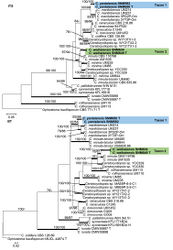Ceratocystiopsis yantaiensis
| Notice: | This page is derived from the original publication listed below, whose author(s) should always be credited. Further contributors may edit and improve the content of this page and, consequently, need to be credited as well (see page history). Any assessment of factual correctness requires a careful review of the original article as well as of subsequent contributions.
If you are uncertain whether your planned contribution is correct or not, we suggest that you use the associated discussion page instead of editing the page directly. This page should be cited as follows (rationale):
Citation formats to copy and paste
BibTeX: @article{Chang2021MycoKeys83, RIS/ Endnote: TY - JOUR Wikipedia/ Citizendium: <ref name="Chang2021MycoKeys83">{{Citation See also the citation download page at the journal. |
Ordo: Ophiostomatales
Familia: Ophiostomataceae
Genus: Ceratocystiopsis
Name
Ceratocystiopsis yantaiensis R.L. Chang & X.Y. Zhang sp. nov. – Wikispecies link – Pensoft Profile
Holotype
China. Shandong province: Kunyushan National Forest Park, Yantai city, from the gallery of Cryphalus piceae on Pinus thunbergii, 2 Sep. 2020, R. L. Chang (HMAS249924-holotype; SNM650 = CGMCC3.20247 – ex-holotype culture).
Additional cultures checked
China. Shandong province: Kunyushan National Forest Park, Yantai city, from the gallery of Cryphalus piceae on Pinus thunbergii, 2 Sep. 2020, R. L. Chang (SNM582).
Etymology
The name refers to Yantai City, where this fungus was isolated.
Diagnosis
Ceratocystiopsis yantaiensis differs from closely related species by the production of smaller conidia.
Description
Sexual morph is unknown. Asexual state hyalorhinocladiella-like: the conidiophores directly arising singly from the vegetative hyphae, measuring (2.4–) 4.7–26.7 (–46.4) μm × (0.8–) 1.0–1.5 (–1.8) μm (Fig. 9d, e); or a short basal cell which continues to develop short lateral and terminal extensions from conidiogenous sites at their apices or discrete basal cells that produce 1–5 branches, which then branch irregularly and form conidiogenous cells at their apices, measuring (12.2–) 6.2–10.2 (–50.7) μm long (Fig. 9b, c); conidiogenous cells measuring (4.7–) 6.2–10.2 (–12.4) × (0.7–) 0.9–1.3(–1.5) μm (Fig. 9b, c); conidia hyaline, smooth, unicellular, short oblong, with rounded ends, measuring (1.1–) 1.4–2.2 (–2.7) × (0.8–) 0.9–1.2 (–1.5) μm (Fig. 9b-e).
Culture characteristics
The Colonies are light brown in color on MEA (Fig. 9a). Mycelia are white, superficially growing on the agar. The optimal temperature for growth was 30–35 °C, reaching 43.0 mm diam in 10 days. No growth was observed at 5 °C.
Distribution
Currently known from Yantai City in Shandong Province, China.
Note
Ceratocystiopsis yantaiensis is phylogenetically close to C. manitobensis, but formed a distinct clade on both ITS, LSU, and BT trees (Figs 1 and 2). Two types of hyalorhinocladiella-like asexual state were also observed in C. manitobensis (Hausner et al. 2003[1]). Conidia of C. yantaiensis and C. manitobensis are similar in morphology, but there is a difference in size (1.1–2.7 × 0.8–1.5 vs. 3.0–5.5 × 1.0–2.0 µm, Fig. 9b-e).
Original Description
- Chang, R; Zhang, X; Si, H; Zhao, G; Yuan, X; Liu, T; Bose, T; Dai, M; 2021: Ophiostomatoid species associated with pine trees (Pinus spp.) infested by Cryphalus piceae from eastern China, including five new species MycoKeys, 83: 181-208. doi
Images
|
Other References
- ↑ Hausner G, Eyjólfsdóttir G, Reid J (2003) Three new species of Ophiostoma and notes on Cornuvesica falcata.Canadian Journal of Botany81: 40–48. https://doi.org/10.1139/b03-009


